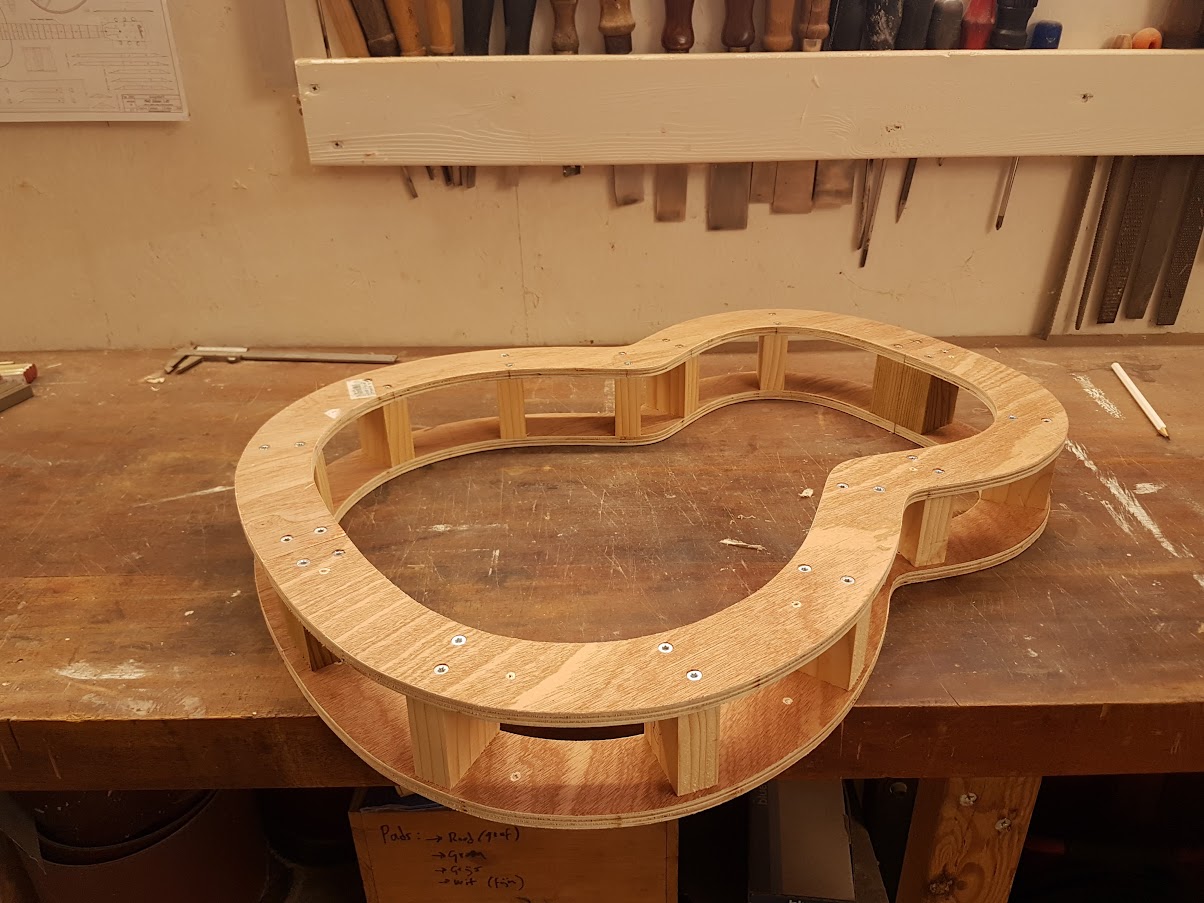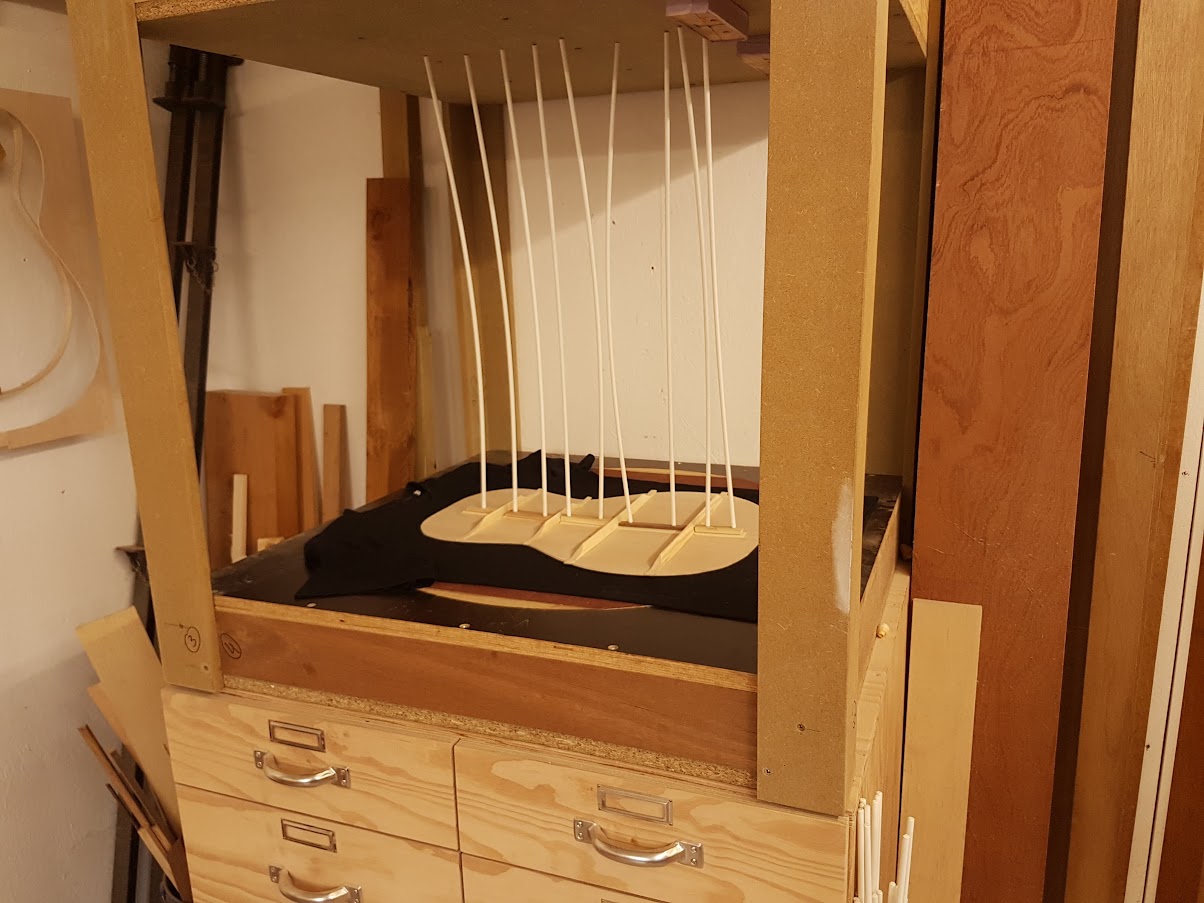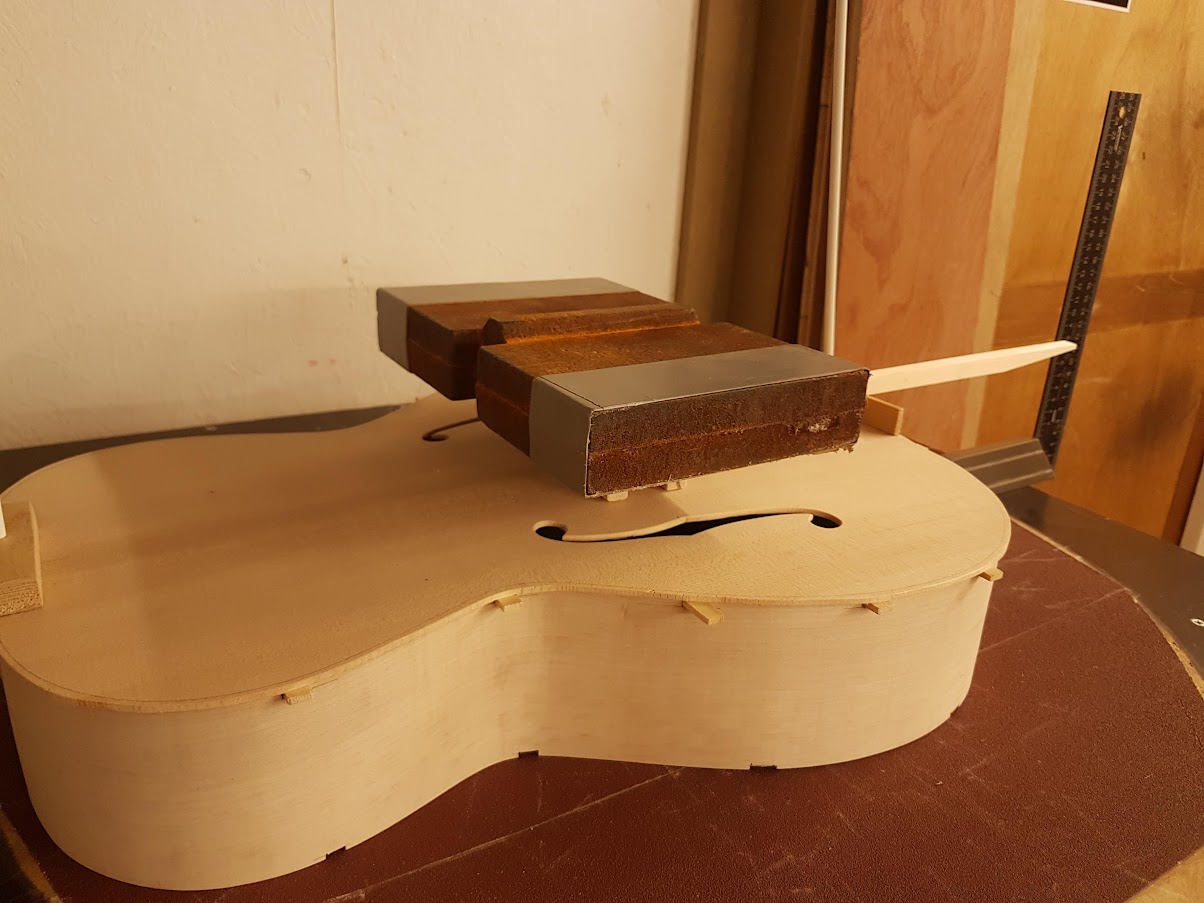Page 1 of 3
Small project
Posted: Sun Feb 27, 2022 5:03 am
by Kurt Temreto
Small project based on an L-30 (L-00) model, where I want to create the arched top using the bracing. Like working with a (flattop) radius dish, but also with a recurve. What do you call such a thing? Tension-arched? Or brace-arched?

Already started making the mold

And bending some maple..
Re: Small project
Posted: Fri Mar 11, 2022 12:37 am
by Clay Schaeffer
I think at one time some arch tops were made by using steam to soften the wood fibers and a mold to press the top into shape, then braces were added to hold it in shape - "Press Tops". It would require a steam press and two piece mold.
Here was one person's home brew solution:
https://www.youtube.com/watch?v=sklkgH4Yxng
Re: Small project
Posted: Fri Mar 11, 2022 5:22 am
by Kurt Temreto
I've read about 'press tops' before, Clay, but so far I've found little information or production images (videos) about it.
However, this is a very nice video about an inventive but also time-consuming solution.
What I want to try is to form the thin top by gluing top and bracing in a negative archtop mould.
Re: Small project
Posted: Sat Mar 12, 2022 10:46 am
by Kurt Temreto

Some progress on the sides

And back of the guitar

Braces and back strip are glued into a 15 foot radius dish

Re: Small project
Posted: Mon Mar 14, 2022 11:38 am
by Kurt Temreto
Soon I will have to make a choice.

What do you think?
Re: Small project
Posted: Mon Mar 14, 2022 12:03 pm
by Peter Wilcox
You have lots of choices. Cat's eye is easier to make and bind.
https://www.google.com/search?q=cat%27s ... =899&dpr=1
Re: Small project
Posted: Wed Mar 16, 2022 6:16 am
by Kurt Temreto
Thanks, Peter, cat eyes will indeed be easier to make, but they're not really my taste.

I keep searching..
Re: Small project
Posted: Wed Mar 16, 2022 2:51 pm
by Eric Crawford
For this shape, and if you do the ‘burst finish, I like A the best of those you have illustrated.
It seems to “fit” better, at least on the flat image.
If your top is curved much that may not hold true.
Re: Small project
Posted: Sat Mar 19, 2022 10:47 am
by Kurt Temreto

Two old pieces of Sitka glued together. AA grade, fine grain but with some discoloration, which shouldn't be a problem as I intend to give this guitar an 'ebony finish'

In the meantime also made an 'arched dish', the layers of the plywood are a useful parameter for shaping the curvature
Re: Small project
Posted: Sat Mar 19, 2022 11:17 am
by Barry Daniels
How deep is the arch?
Re: Small project
Posted: Sat Mar 19, 2022 12:55 pm
by Kurt Temreto
As with an L-30, Barry, the fretboard will rest on the top, so no elevation. And I want to have a string break angle of about 14 degrees at the bridge. Taking into account the height of the bridge I need a curvature about 7 mm. Or about the same height as a Selmer-Maccaferri?
Re: Small project
Posted: Thu Mar 24, 2022 2:22 pm
by Alan Carruth
I only watched a little of that video, so there may be some overlap here, but there is a traditional technique for forming arches that, while it doesn't result in a completed arch right away, minimizes the amount of work needed, and stock to be removed, to get there. This was used on viols da gamba, which often had three or even five piece tops that were largely bent to shape, with this method being mostly used for the outer pieces. I can't point you to photo of this, but I have seen such. I'm told that Smallman uses this method to make the BRW arched backs for his lattice topped Classicals.
Start with a book matched set that is larger in outline than needed, and thicker too; I understand they often start with wood that's about 5-6 mm thick. Cut the two halves to a rough outline that is 1" or more larger all around than the final shape, and leave some extra wood on the join side too. Cut out a pair of clamping cauls that are an inch or more wide, and match the outline on their inside edge. Make up a set of wedges that roughly match the arch you want in several places along the length of the top, mirrored vertically, so that each one is twice as tall as the desired arch at the wide end. These need not be super precise. When you've got everything ready the top halves are steamed, and clamped between the cauls around the outside. The wedges are then driven in from the center to form the arches. Once the wood has dried out well you remove the two halves from the cauls an join them along the center line. Typically the bent pieces are made thicker than desired, and the top is then carved to final shape and graduated.
I've never done this, which is why I don't have any photos to share. I would guess that it takes a bit of practice to get it right.
Re: Small project
Posted: Fri Mar 25, 2022 3:52 am
by Kurt Temreto
Sounds like an interesting challenge, Alan. In the meantime I also found this ten year old thread:
viewtopic.php?t=706 (and perhaps there is still information about it hidden in this forum?)
But with my project I want to try it without steam..
Re: Small project
Posted: Wed Mar 30, 2022 11:06 am
by Kurt Temreto
Re: Small project
Posted: Wed Mar 30, 2022 11:13 am
by Barry Daniels
Our own Mark Swanson used laminated braces so there is nothing wrong with that. But the two long braces look a bit beefy to me. I would be tempted to taper the heck out of them.
Re: Small project
Posted: Wed Mar 30, 2022 3:26 pm
by Alan Carruth
I agree: those longitudinal braces only need to be tall at the bridge location. They can go down to almost nothing at the ends. Look at a violin bass bar.
Fred Carlson uses laminated bracing in his creations. I've never gone that route, for two reasons:
1) I wonder about the damping in all of those glue lines. A lot would depend on what glue you use, of course. Titebond is said to have high damping, while I imagine that hide glue is quite low. There have been discussions of this from time to time. It's hard to get good data that people will accept; how do you factor in the damping of the wood, for example? If you use something else, like metal or glass, can you be sure that the glue bond works the same way?
2) Many glues, including Titebond, will cold creep under a sustained shear load over time. White glue is infamous for this. I once got in a nice violin for repair that was flat all along the bass bar side of the top. I figured the bar had come unglued at the ends, but it wasn't so; it was tight at both ends. It had been glued with white glue back in the '40s some time, and had distorted with age. I had to use hot sandbags to get some arch back into the top before gluing in a very highly 'sprung' bar with hide glue. Titebond is not as bad as school glue, but some of the substitutes are. I've seen bridges on guitars that have slid toward the neck by a mm or more, and were still glued down. You see the gap in the finish along the back edge. I made a number of tailpieces for archtop guitars using laminated rings, built up with Titebond, several years ago, and they have pulled themselves apart.
Re: Small project
Posted: Thu Mar 31, 2022 2:35 am
by Kurt Temreto
The bracing is essentially not much heavier than an average archtop guitar, I think, the longitudinal braces measure 8mm x 15mm. And with an archtop you have a thicker top and a higher arch.
For the shape and dimensions of the braces, I was somewhat guided by a Manouche guitar (like a Maccaferri, for example). There, the braces under the bridge also retain their full shape, while they are shorter due to their transverse placement. With a Manouche, the downward pressure is also absorbed by the 'pliage'. 20 Kilos is a lot of pressure..
Maybe I'll lighten the braces a bit if the top is glued to the sides, I'll see..
Re: Small project
Posted: Sat Apr 02, 2022 4:18 am
by Kurt Temreto

Top and sides glued together

Then I made a kind of primitive measurement setup

So that it can be determined how the top reacts under the downward string pressure

First try with a weight of 10 kilos..

That gives a difference of 0.5 millimeters

With another 10 kilos we are at the calculated downward pressure of 20 kilos

Add another half millimeter. At 20 kilos, the top goes down 1 millimeter..
I doubt if I want to make the braces much lighter. What do you think, Barry and Alan?
Re: Small project
Posted: Sat Apr 02, 2022 6:35 pm
by Alan Carruth
I'd be interested to see what happens under the actual string load. I suspect a tailpiece pushing the top inward along its length should cause it to rise, and balance at least some of the down load.
Re: Small project
Posted: Sun Apr 03, 2022 4:22 am
by Kurt Temreto
You're right, Alan, I also made this thought: what about the combination of 20 kg of downward pressure and a force of 80 kg in the length of the top? And what effect do these forces have on a lighter bracing?
I could test that by placing a bar clamp on the body lengthwise, but how do I measure the force of that bar clamp?

